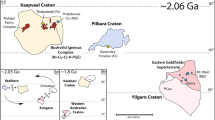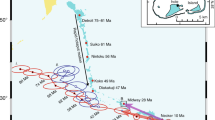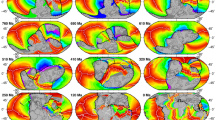Abstract
Resolving flow geometry in the mantle wedge is central to understanding the thermal and chemical structure of subduction zones, subducting plate dehydration, and melting that leads to arc volcanism, which can threaten large populations and alter climate through gas and particle emission. Here we show that isotope geochemistry and seismic velocity anisotropy provide strong evidence for trench-parallel flow in the mantle wedge beneath Costa Rica and Nicaragua. This finding contradicts classical models, which predict trench-normal flow owing to the overlying wedge mantle being dragged downwards by the subducting plate. The isotopic signature of central Costa Rican volcanic rocks is not consistent with its derivation from the mantle wedge1,2,3 or eroded fore-arc complexes4 but instead from seamounts of the Galapagos hotspot track on the subducting Cocos plate. This isotopic signature decreases continuously from central Costa Rica to northwestern Nicaragua. As the age of the isotopic signature beneath Costa Rica can be constrained and its transport distance is known, minimum northwestward flow rates can be estimated (63–190 mm yr-1) and are comparable to the magnitude of subducting Cocos plate motion (∼85 mm yr-1). Trench-parallel flow needs to be taken into account in models evaluating thermal and chemical structure and melt generation in subduction zones.
This is a preview of subscription content, access via your institution
Access options
Subscribe to this journal
Receive 51 print issues and online access
$199.00 per year
only $3.90 per issue
Buy this article
- Purchase on Springer Link
- Instant access to full article PDF
Prices may be subject to local taxes which are calculated during checkout



Similar content being viewed by others
References
Feigenson, M. D., Carr, M. J., Maharaj, S. V., Juliano, S. & Bolge, L. L. Lead isotope composition of Central American volcanoes: Influence of the Galapagos plume. Geochem. Geophys. Geosyst. 5 Q06001 10.1029/2003GC000621 (2004)
Herrstrom, E. A., Reagan, M. K. & Morris, J. D. Variations in lava composition associated with flow of asthenosphere beneath southern Central America. Geology 23, 617–620 (1995)
Abratis, M. & Wörner, G. Ridge collision, slab window formation, and the flux of Pacific asthenosphere into the Caribbean realm. Geol. Soc. Am. 29, 127–130 (2001)
Goss, A. R. & Kay, S. M. Steep REE patterns and enriched Pb isotopes in southern Central American arc magmas: Evidence for forearc subduction erosion? Geochem. Geophys. Geosyst. 7 Q05016 10.1029/2005GC001163 (2006)
Jung, H. & Karato, S.-i. Water-induced fabric transition in olivine. Science 293, 1460–1463 (2001)
Kneller, E. A., van Keken, P. E., Karato, S.-i. & Park, J. B-type olivine fabric in the mantle wedge: Insights from high-resolution non-Newtonian subduction zone models. Earth Planet. Sci. Lett. 237, 781–797 (2005)
Nakajima, J., Shimizu, J., Hori, S. & Hasegawa, A. Shear-wave splitting beneath the southwestern Kurile arc and northeastern Japan arc: A new insight into mantle return flow. Geophys. Res. Lett. 33 L05305 10.1029/2005GL025053 (2006)
Long, M. D. & van der Hilst, R. D. Upper mantle anisotropy beneath Japan from shear wave splitting. Phys. Earth Planet. Inter. 151, 206–222 (2006)
Smith, G. P. et al. A complex pattern of mantle flow in the Lau backarc. Science 292, 713–716 (2001)
Levin, V., Droznin, D., Park, J. & Gordeev, E. Detailed mapping of seismic anisotropy with local shear waves in southeastern Kamchatka. Geophys. J. Int. 158, 1009–1023 (2004)
Anderson, M. L., Zandt, G. & Wagner, L. Along-strike mantle flow variations in a segment of the South American subduction zone, Chile and Argentina. Earth Planet. Sci. Lett. (submitted)
Pozgay, S. H., Wiens, D. A., Conder, J. A., Shiobara, H. & Sugioka, H. Complex mantle flow in the Mariana subduction system: Evidence from shear wave splitting. Geophys. J. Int. 107, 371–386 (2007)
Hall, C. E., Fischer, K. M. & Parmentier, E. M. The influence of plate motions on three dimensional back-arc mantle flow and shear wave splitting. J. Geophys. Res. 105, 28009–28033 (2000)
Holtzman, B. K. et al. Melt segregation and strain partitioning: Implications for seismic anisotropy and mantle flow. Science 301, 1227–1230 (2003)
Behn, M. D., Hirth, G. & Kelemen, P. B. Trench-parallel anisotropy produced by foundering of arc lower crust. Science 317, 108–111 (2007)
Kneller, E. A. & van Keken, P. E. Trench-parallel flow and seismic anisotropy in the Mariana and Andean subduction systems. Nature 450, 1222–1225 (2007)
Reagan, M. K. & Gill, J. B. Coexisting calcalkaline and high-niobium basalts from Turrialba volcano, Costa Rica: Implications for residual titanates in arc magma sources. J. Geophys. Res. 94, 4619–4633 (1989)
Hoernle, K. A., Werner, R., Phipps Morgan, J., Bryce, J. & Mrazek, J. Existence of a complex spatial zonation in the Galápagos plume for at least 14.5 Ma. Geology 28, 435–438 (2000)
Werner, R., Hoernle, K., Barckhausen, U. & Hauff, F. Geodynamic evolution of the Galapagos hot spot system (Central East Pacific) over the past 20 m.y.: Constraints from morphology, geochemistry, and magnetic anomalies. Geochem. Geophys. Geosyst. 4 10.1029/2003GC000576 (2003)
Defant, M. J. et al. The geology and geochemistry of El Valle volcano, Panama: Andesite and dacite genesis via contrasting processes. Contrib. Mineral. Petrol. 106, 309–324 (1991)
MacMillan, I., Gans, P. B. & Alvarado, G. Middle Miocene to present plate tectonic history of southern Central American volcanic arc. Tectonophysics 392, 325–348 (2004)
Hoernle, K., Hauff, F. & van den Bogaard, P. 70 m.y. history (139–69 Ma) for the Caribbean large igneous province. Geology 32, 697–700 (2004)
Hauff, F., Hoernle, K. A., van den Bogaard, P., Alvarado, G. E. & Garbe-Schönberg, D. Age and geochemistry of basaltic complexes in Western Costa Rica: Contributions to the geotectonic evolution of Central America. Geochem. Geophys. Geosyst. 1 10.1029/1999GC000020 (2000)
Hoernle, K. A. et al. The missing history (16–71 Ma) of the Galápagos hotspot: Implications for the tectonic and biological evolution of the Americas. Geology 30, 795–798 (2002)
Patino, L. C., Carr, M. J. & Feigenson, M. D. Local and regional variations in Central American arc lavas controlled by variations in subducted sediment input. Contrib. Mineral. Petrol. 138, 265–283 (2000)
Carr, M. J., Feigenson, M. D. & Bennett, E. A. Incompatible element and isotopic evidence for tectonic control of source mixing and melt extraction along the Central American arc. Contrib. Mineral. Petrol. 105, 369–380 (1990)
Kimura, G. et al. SITE 1039 (Ch. 3); SITE 1040 (Ch. 4). Proc. ODP Init. Rep. 170, 45–152 (1997)
Abt, D. L. & Fischer, K. M. Resolving three-dimensional anisotropic structure with shear-wave splitting tomography. Geophys. J. Int. (submitted)
Turner, H. L. et al. Kinematics of the Nicaraguan forearc from GPS geodesy. Geophys. Res. Lett. 34 L02302 10.1029/2006GL027586 (2007)
Alvarado, G. E. et al. in Central America: Geology, Resources and Hazards (eds Bundschuh, J. & Avarado, G.) 345–394 (Taylor and Francis, Leiden, 2007)
Hoernle, K. A. & Tilton, G. R. Sr-Nd-Pb isotope data for Fuerteventura (Canary Islands) basal complex and subaerial volcanics: Applications to magma genesis and evolution. Schweiz. Mineral. Petrogr. Mitt. 71, 3–18 (1991)
Todt, W., Cliff, R. A., Hanser, A. & Hofmann, A. W. in Earth Processes: Reading the Isotopic Code (eds Basu, A. & Hart, S.) 429–437 (AGU Geophys. Monogr. Ser. 95, American Geophysical Union, Washington DC, 1996)
Silver, P. G. & Chan, W. W. Shear wave splitting and subcontinental mantle deformation. J. Geophys. Res. 96, 16429–16454 (1991)
Frisillo, A. L. & Barsch, G. R. Measurement of single-crystal elastic constants of bronzite as a function of pressure and temperature. J. Geophys. Res. 77, 6360–6384 (1972)
Anderson, O. L. & Isaak, D. G. in Mineral Physics and Crystallography: A Handbook of Physical Constants (ed. Ahrens, T. J.) 64–97 (American Geophysical Union, Washington DC, 1995)
Abramson, E. H., Brown, J. M., Slutsky, L. J. & Zaug, J. The elastic constants of San Carlos olivine to 17 GPa. J. Geophys. Res. 102, 12253–12263 (1997)
Fischer, K. M., Parmentier, E. M., Stein, A. R. & Wolf, E. R. Modeling anisotropy and plate-driven flow in the Tonga subduction zone back arc. J. Geophys. Res. 105, 16181–16191 (2000)
Acknowledgements
Reviewers (J. Walker and S. Schwartz), J. Phipps-Morgan, T. Plank, R. Werner, M. Portnyagin and members of SFB574 and MARGINS are thanked for comments/discussions that helped significantly improve the manuscript. The IRIS PASSCAL programme provided seismometers and technical assistance to the TUCAN experiment. This research was supported by the German Science Foundation Collaborative Research Centre (SFB574) and the National Science Foundation MARGINS programme.
Author Contributions K.H., D.L.A. and K.M.F. collected samples/data, processed and interpreted the data, developed the ideas and wrote the paper, with significant input from G.A.A. and discussions with other co-authors. H.N., F.H. and K.H. generated the geochemical data and P.v.d.B. age data. G.A.A., M.P. and W.S. were key in collecting the seismic data; P.v.d.B., G.A. and H.N. assisted in the collection of the volcanic samples. Central American partners provided geological overviews and logistical support.
Author information
Authors and Affiliations
Corresponding author
Supplementary information
Supplementary Information 1
The file contains Section 1 of the Supplementary Information concerning Geochemistry. It includes Supplementary Discussion on the role of sediments in influencing isotopic variation in volcanic arc lavas and Supplementary Figures S1.1-S1.2. (PDF 3503 kb)
Supplementary Information 2
The file contains Section 2 of the Supplementary Information concerning Seismology. It includes Supplementary Discussion on the interpretation of seismic anisotropy measurements and tomographic models and Supplementary Figures S2.1-S2.4. (PDF 4158 kb)
Rights and permissions
About this article
Cite this article
Hoernle, K., Abt, D., Fischer, K. et al. Arc-parallel flow in the mantle wedge beneath Costa Rica and Nicaragua. Nature 451, 1094–1097 (2008). https://doi.org/10.1038/nature06550
Received:
Accepted:
Published:
Issue Date:
DOI: https://doi.org/10.1038/nature06550
This article is cited by
-
Seismic anisotropy to investigate lithospheric-scale tectonic structures and mantle dynamics in southern Italy
Scientific Reports (2023)
-
Evidence for compositionally distinct upper mantle plumelets since the early history of the Tristan-Gough hotspot
Nature Communications (2023)
-
Chemical composition of sediments from the subducting Cocos Ridge segment at the Southern Central American subduction zone
Acta Oceanologica Sinica (2022)
-
Seismic evidence for subduction-induced mantle flows underneath Middle America
Nature Communications (2020)
-
The origin of arc basalts: New advances and remaining questions
Science China Earth Sciences (2020)
Comments
By submitting a comment you agree to abide by our Terms and Community Guidelines. If you find something abusive or that does not comply with our terms or guidelines please flag it as inappropriate.



